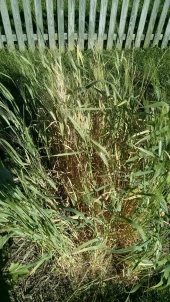The grain looks immature to me. It's probably viable already. I'd expect it to continue to store starches for a couple more weeks. I typically don't harvest grains until they are dry enough to start shattering. You can hedge your bets by collecting some now, and some later. It would suck to have a species of bird in your area that decides to eat every grain in a day.
I typically harvest scattered grain plants, or small/weedy patches with a pair of secateurs. Cut off the seed heads. Collect them into a bucket. Spread them out to dry. Jump up and down on them to thresh, or beat with a stick. Winnow.
I really like this configuration for removing the glumes from older wheats... 1/2 inch vinyl coated hardware cloth. Rub the glumes off with an old rubber soled shoe.
De-gluming black wheat.








